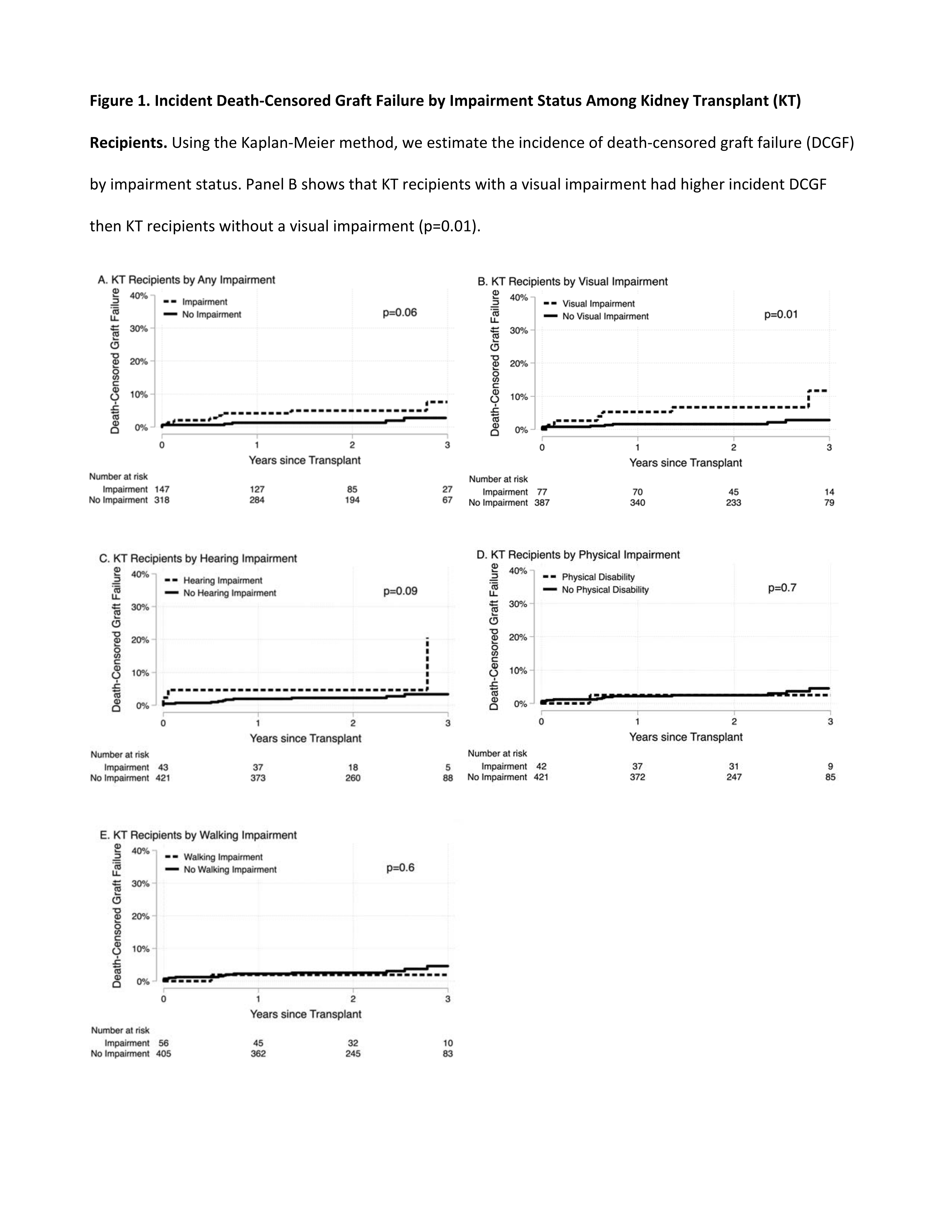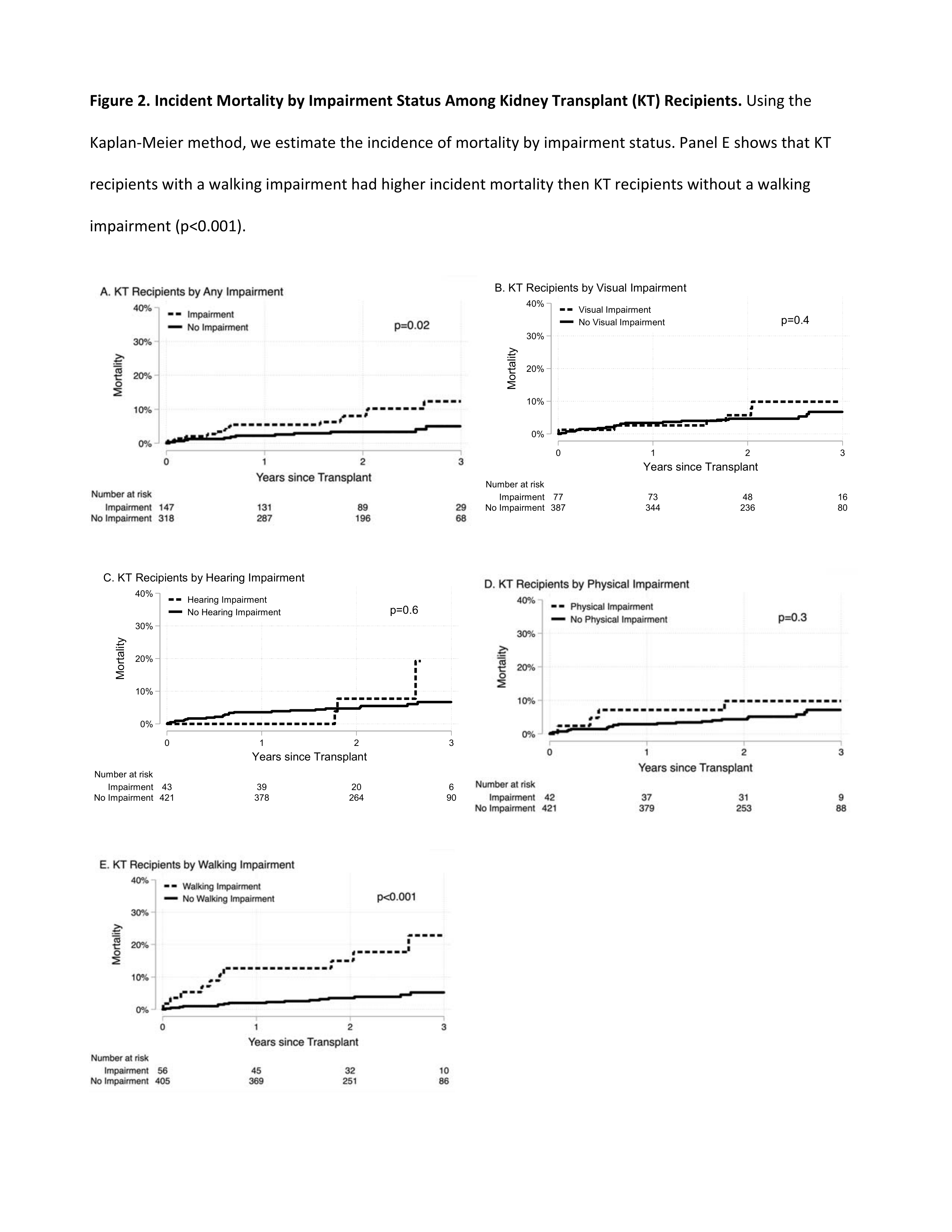Kidney Transplant Outcomes in Recipients with Physical Impairments
1Epidemiology, UNC Chapel Hill, Chapel Hill, NC, 2Johns Hopkins University, Baltimore, MD, 3University of Michigan, Ann Arbor, MI
Meeting: 2019 American Transplant Congress
Abstract number: D170
Keywords: Graft survival, Kidney transplantation, Multicenter studies, Risk factors
Session Information
Session Name: Poster Session D: Non-Organ Specific: Disparities to Outcome and Access to Healthcare
Session Type: Poster Session
Date: Tuesday, June 4, 2019
Session Time: 6:00pm-7:00pm
 Presentation Time: 6:00pm-7:00pm
Presentation Time: 6:00pm-7:00pm
Location: Hall C & D
*Purpose: Disability in general has been associated with poor outcomes in KT recipients. However, disability can be derived from various components, specifically visual, hearing, physical, and walking impairments. We hypothesized that these different impairments compromise the patient through different mechanisms and, as such, might impact different aspects of KT outcomes.
*Methods: In our prospective 2-center cohort study (6/2013-6/2017), 465 recipients reported hearing, visual, physical, and walking impairments prior to KT. We used hybrid registry-augmented Cox regression, by adjusting for confounders using the national KT population (SRTR N=66,891), to assess the independent association between impairments and post-KT outcomes (death-censored graft failure [DCGF] and mortality).
*Results: 31.6% of recipients reported at least one impairment (hearing=9.3%, visual=16.6%, physical=9.1%, and walking=12.1%). Visual impairment was associated with a 3.36-fold (95%CI:1.17-9.65; p=0.02) higher DCGF risk; however, hearing (aHR=2.77;95%CI:0.78-9.82), physical (aHR=0.67; 95%CI:0.08-3.35), and walking (aHR=0.50;95%CI:0.06-3.89) impairments were not. Walking impairment was associated with a 3.13-fold (95%CI:1.32-7.48; p=0.01) higher mortality risk; however, visual (aHR=1.20;95%CI:0.48-2.98), hearing (aHR=1.01;95%CI:0.29-3.47), and physical (aHR=1.16;95%CI:0.34-3.94) impairments were not.
*Conclusions: In this cohort, 31.6% of KT recipients reported 1 impairment. Recipients with visual impairment were at higher DCGF risk; those with walking impairments were at higher mortality risk. No other impairments were associated with post-KT outcomes. Transplant centers should identify recipients with visual and walking impairments who might benefit from targeted interventions pre-KT, additional supportive care, and close post-transplant monitoring.
To cite this abstract in AMA style:
Thomas AG, Ruck J, Chu N, Agoons D, Shaffer A, Haugen C, Ying H, Swenor B, Norman S, Garonzik-Wang J, Segev D, McAdams-DeMarco M. Kidney Transplant Outcomes in Recipients with Physical Impairments [abstract]. Am J Transplant. 2019; 19 (suppl 3). https://atcmeetingabstracts.com/abstract/kidney-transplant-outcomes-in-recipients-with-physical-impairments/. Accessed December 13, 2025.« Back to 2019 American Transplant Congress


